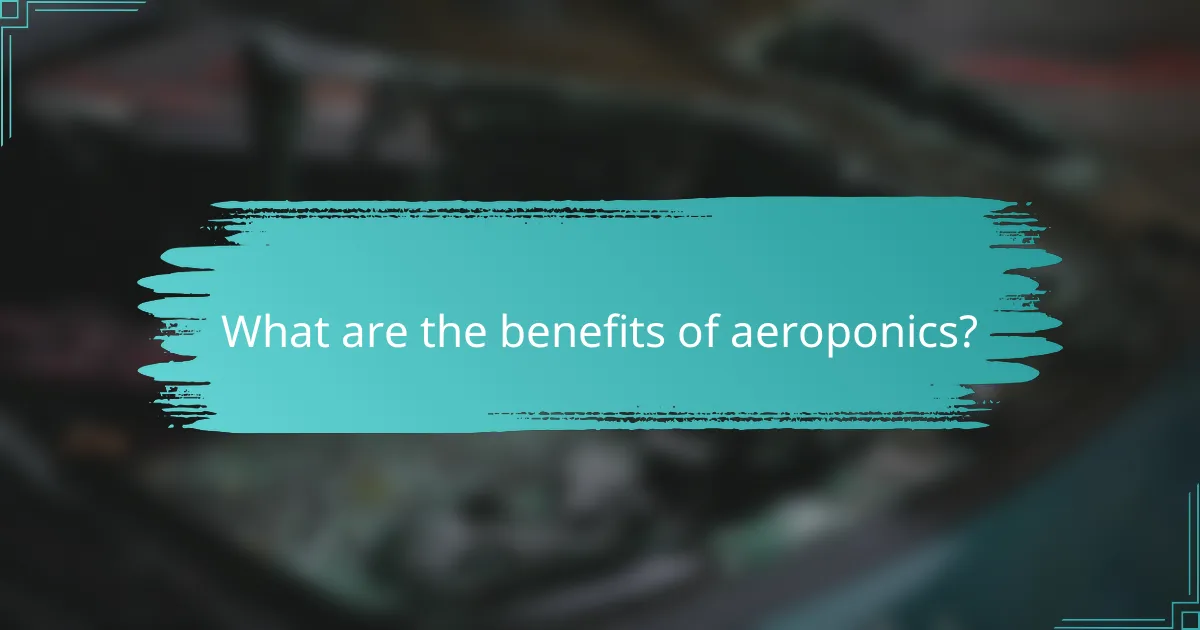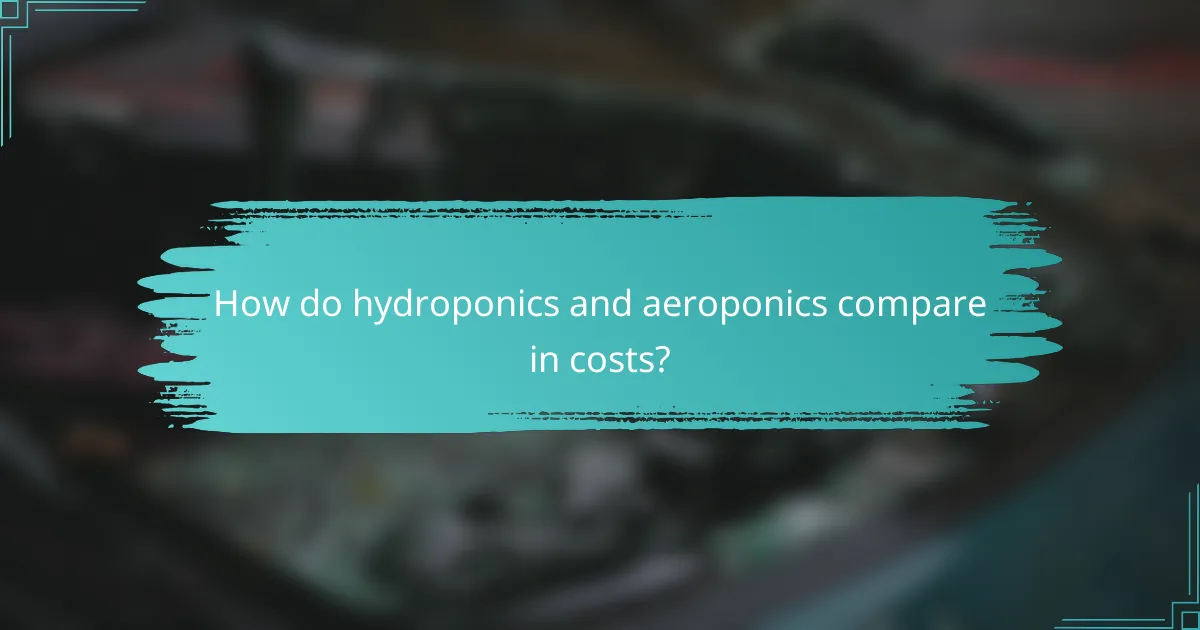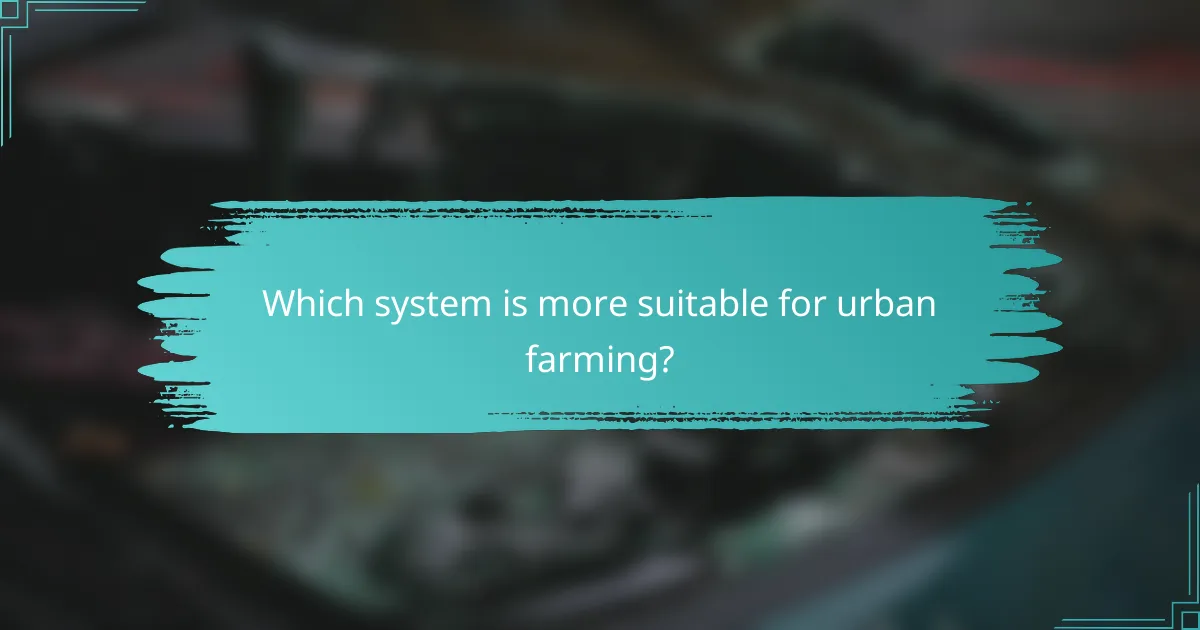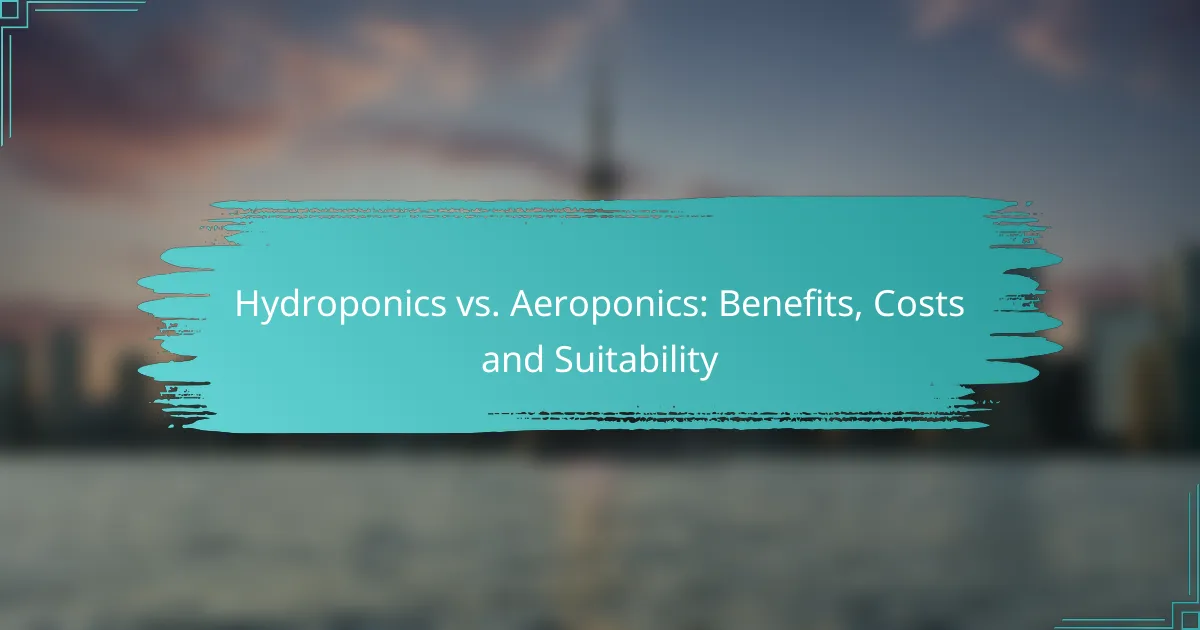Hydroponics and aeroponics are innovative soil-less growing methods that offer unique benefits for cultivating plants. Hydroponics is known for its increased crop yields and efficient water usage, while aeroponics enhances root oxygen exposure and reduces nutrient costs. Understanding the advantages, costs, and suitability of each system is essential for making informed decisions in modern agriculture.

What are the benefits of hydroponics?
Hydroponics offers several advantages, including increased crop yields, efficient water usage, and reduced pesticide reliance. These benefits make it an attractive option for both commercial growers and home gardeners.
Higher crop yields
Hydroponic systems can produce significantly higher crop yields compared to traditional soil-based farming. This is largely due to the controlled environment and optimized nutrient delivery, which allows plants to grow faster and healthier. For instance, some hydroponic farms report yields that are 20-30% greater than those from conventional methods.
Growers can maximize their output by selecting high-yield varieties and utilizing techniques such as vertical farming. This approach not only increases production but also allows for year-round cultivation, further enhancing profitability.
Water efficiency
Hydroponics uses up to 90% less water than traditional agriculture, making it an eco-friendly choice. Water in hydroponic systems is recirculated, minimizing waste and ensuring that plants receive the moisture they need without excess runoff.
This efficiency is particularly beneficial in regions facing water scarcity. By adopting hydroponic methods, growers can contribute to sustainable water management while still achieving robust crop production.
Space-saving techniques
Hydroponics allows for innovative space-saving techniques, such as vertical farming and stacked systems. These methods enable growers to maximize their use of limited space, making it ideal for urban environments or areas with high land costs.
By utilizing vertical structures, growers can increase their planting area without requiring additional land, which is especially advantageous in densely populated regions. This approach can lead to significant cost savings and improved accessibility to fresh produce.
Reduced pesticide use
Hydroponic systems typically require fewer pesticides than traditional farming due to the controlled environment that minimizes pest infestations. This reduction not only lowers costs but also results in cleaner, healthier produce.
Many hydroponic growers adopt integrated pest management (IPM) strategies, which further decrease the need for chemical interventions. This practice aligns with consumer demand for organic and sustainably grown food, enhancing market appeal.
Faster growth cycles
Plants grown hydroponically often experience faster growth cycles compared to those grown in soil. This acceleration is due to the direct access to nutrients and optimal growing conditions, which can lead to harvests in a matter of weeks rather than months.
For instance, leafy greens can be harvested in as little as 3-4 weeks in a hydroponic system, while traditional methods may take twice as long. This rapid turnover allows growers to increase their production frequency and profitability.

What are the benefits of aeroponics?
Aeroponics offers several advantages over traditional growing methods, including enhanced oxygen exposure for roots, reduced nutrient costs, and efficient water usage. These benefits contribute to faster plant growth and a lower risk of disease, making aeroponics a compelling choice for modern agriculture.
Maximized oxygen exposure
Aeroponics delivers nutrients and water directly to plant roots in a mist form, allowing for maximum oxygen exposure. This high level of oxygen promotes healthier root systems, which can lead to more vigorous plant growth. Plants that receive ample oxygen are generally more resilient and can better absorb nutrients.
To optimize oxygen levels, ensure that the misting system operates effectively and that the roots are not submerged in water. Regular monitoring of the misting intervals can help maintain ideal conditions.
Lower nutrient costs
Aeroponic systems use significantly less nutrient solution compared to traditional hydroponics, leading to lower overall nutrient costs. Since nutrients are delivered directly to the roots in a highly efficient manner, plants require smaller quantities to thrive.
Consider using concentrated nutrient solutions designed specifically for aeroponic systems to maximize efficiency. This can further reduce costs while ensuring plants receive the necessary elements for growth.
Minimal water usage
Aeroponics is known for its minimal water usage, utilizing up to 90% less water than conventional soil gardening. The closed-loop system recycles water, which means that only a small amount is lost through evaporation or misting.
To achieve optimal water efficiency, regularly check the system for leaks and ensure that the misting intervals are appropriately set. This will help maintain a sustainable growing environment while conserving water resources.
Faster plant growth
Due to the efficient delivery of nutrients and oxygen, plants grown in aeroponic systems often experience faster growth rates compared to those in soil or traditional hydroponics. Many growers report that plants can mature in a fraction of the time, leading to quicker harvests.
To capitalize on this benefit, maintain consistent environmental conditions, such as temperature and humidity, which can further enhance growth rates. Regularly adjusting light exposure can also contribute to faster development.
Less risk of disease
Aeroponics reduces the risk of soil-borne diseases, as plants are grown without soil. The controlled environment limits exposure to pathogens, leading to healthier crops. This is particularly beneficial for high-value crops that are sensitive to disease.
To minimize disease risks, ensure that your aeroponic system is clean and well-maintained. Regularly sterilizing equipment and monitoring for any signs of disease can help maintain plant health and productivity.

How do hydroponics and aeroponics compare in costs?
Hydroponics and aeroponics have distinct cost structures that can significantly affect your decision on which system to implement. While initial investments may be higher for aeroponics, operational and maintenance costs can vary, impacting long-term profitability.
Initial setup costs
The initial setup costs for hydroponics typically range from a few hundred to several thousand dollars, depending on the scale and complexity of the system. Aeroponics systems often require more advanced technology, leading to higher upfront costs, which can start at around a thousand dollars and go up significantly for larger operations.
When planning your budget, consider the cost of equipment such as pumps, reservoirs, and lighting. Additionally, aeroponics may necessitate more sophisticated sensors and controls, which can add to the initial investment.
Operational costs
Operational costs for hydroponics generally include water, electricity, and labor. These costs can be relatively low, especially if you utilize efficient systems. Aeroponics, while potentially more efficient in water usage, may have higher energy costs due to the need for constant misting and monitoring.
It’s essential to calculate your local utility rates and factor in the potential savings from reduced water consumption in aeroponics, which can offset some operational expenses.
Maintenance costs
Maintenance costs for hydroponics are usually manageable, involving regular checks on nutrient levels and system cleanliness. Aeroponics systems may require more frequent maintenance due to the complexity of the misting apparatus and the need to prevent clogs.
Consider setting aside a budget for unexpected repairs, especially for aeroponics, as the technology can be more sensitive to malfunctions.
Cost of nutrients
The cost of nutrients for both hydroponics and aeroponics can vary based on the crops grown and the nutrient formulations used. Hydroponics may require a broader range of nutrients, while aeroponics often uses concentrated solutions, which can be more cost-effective.
Evaluate the nutrient needs of your specific plants and compare prices from local suppliers to find the most economical options for your chosen system.
Long-term profitability
Long-term profitability in hydroponics can be favorable due to lower ongoing costs and the ability to grow a variety of crops. Aeroponics, while initially more expensive, can lead to higher yields and faster growth rates, potentially increasing profitability over time.
To maximize profitability, consider crop selection and market demand, as well as the scalability of your system. Regularly assess your operational efficiency to ensure that your investment yields the best returns.

Which system is more suitable for urban farming?
Both hydroponics and aeroponics can be suitable for urban farming, but the choice depends on space availability, resource accessibility, and specific farming goals. Hydroponics typically suits larger areas, while aeroponics excels in compact, vertical setups.
Hydroponics for larger spaces
Hydroponics is ideal for larger urban farming spaces, as it allows for extensive crop cultivation in a controlled environment. Systems can range from simple nutrient film techniques to more complex deep water culture setups, accommodating a variety of plants.
When considering hydroponics, ensure you have adequate space for larger reservoirs and grow beds. This method often requires more initial investment in equipment, but it can yield substantial harvests over time, making it cost-effective for larger operations.
Aeroponics for vertical farming
Aeroponics is particularly well-suited for vertical farming, where space is limited. This method uses a misting system to deliver nutrients directly to plant roots, allowing for high-density planting and efficient use of vertical space.
For urban farmers looking to maximize yield in small areas, aeroponics can be a game-changer. It typically requires less water than hydroponics and can lead to faster plant growth, making it an attractive option for urban environments.
Accessibility of resources
Accessibility to resources plays a crucial role in determining the suitability of hydroponics or aeroponics for urban farming. Hydroponics may require more specialized equipment and nutrient solutions, which can be challenging to source in some urban areas.
Aeroponics, on the other hand, often uses simpler systems that can be built with readily available materials. Urban farmers should assess local suppliers for nutrient solutions and equipment to ensure they can maintain their chosen system effectively.
Local climate considerations
Local climate significantly influences the choice between hydroponics and aeroponics in urban farming. Hydroponics can be more forgiving in various climates, as it allows for controlled growing conditions, making it suitable for regions with extreme temperatures.
Aeroponics, while efficient, may require more precise environmental controls, such as humidity and temperature regulation. Urban farmers should evaluate their local climate and consider investing in climate control technologies if opting for aeroponics to ensure optimal plant growth.
